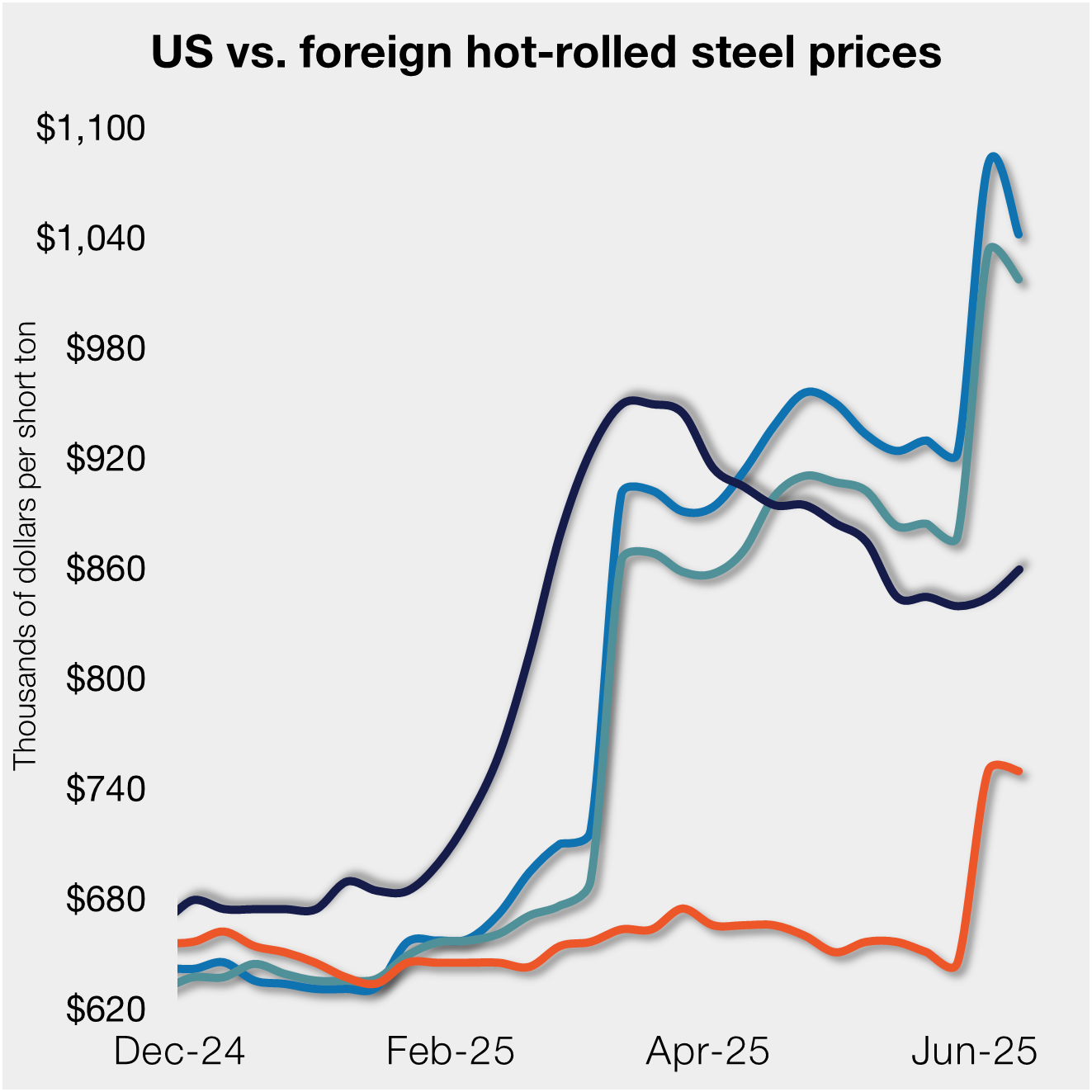International Steel Prices

CRU: U.S. Buying Landscape in Flux with Prices Falling, Trade Talks
Written by Estelle Tran
November 18, 2021
By CRU Senior Prices Analyst Estelle Tran, from CRU’s Global Steel Trade Service, Nov. 18
In the last several weeks, U.S. sheet prices have started to decline, though prices remain well above global prices. Under pressure from imports and service centers eager to sell high-cost inventory before the end of the year, prices for processed sheet to end-users have plummeted below mill spot prices for coils in many cases. With domestic and imported prices falling and mill lead time shortening, U.S. mills have been more willing to offer “foreign fighter” deals – sales for volumes usually 1kt or more at significantly lower prices meant to deter buyers from placing import orders.
The CRU U.S. Midwest HR coil price of $1,786 /s.ton FOB mill on Nov. 17 was down $119 /s.ton m/m from the Oct. 20 price of $1,905 /s.ton. Prices for HR coil imports arriving January-April have fallen within a wide range of $1,250-1,400 /s.ton on a loaded truck basis in Houston from Mexico, South Korea and Serbia. With HR coil falling faster than CR and HDG coil and mills offering foreign fighter deals, buyers have been less eager to place orders for HR coil. Market contacts have reported competitive prices from Turkey, Vietnam and other origins for CR and HDG coil, and because of tighter supply and higher domestic prices, imports for these products may be more attractive than the offers for HR coil.
So far, workable import offers from the EU have been scarce, though that may change with the U.S. poised to drop Section 232 (S232) tariffs against the EU on Jan. 1, 2022. Light flat rolled imports had been arriving consistently from Germany and the Netherlands even with the 25% S232 tariff.
Removal of the S232 tariff should help Spanish rebar compete with Turkish and Algerian material in the U.S. market as well. Continued supply tightness domestically for wire rod particularly, as well as rebar, boosted prices in November, and prices are expected to climb again in December with the additional support of rising scrap prices. The absence of the S232 tariff, rising domestic prices, and tight supply driven by mill maintenance outages could also make German wire rod more attractive.
U.S. Reworking Trade Disputes
The U.S. will drop the 25% S232 tariffs that apply to steel imports from the EU beginning on Jan. 1 and replace the tariffs with a tariff-rate quota. The tariff-rate quota will cover 54 product categories representing 3.3 Mt where a 25% tariff will apply when imports exceed a threshold set by historical import levels based on imports from 2015-2017. The removal of the 25% tariffs will benefit U.S. manufacturers, particularly those that rely on harder-to-get items, such as tin plate, imports of which have continued to arrive in the U.S. regardless of the tariff. However, the imposition of tariff-rate quotas on steel imported from the EU is unlikely to spark an uncontrolled surge of imports in the short term or even longer term because of structural changes made in the North American market. As we said in a CRU Insight, we expect the new sheet capacity installed and planned in the U.S. and Mexico will bring the U.S. closer to trade neutral for sheet products, reducing demand for imports subject to S232 tariffs. The spike in imports in H2 has been largely supported by the hefty premium of U.S. steel pricing relative to other markets, however, import levels are expected to diminish now that U.S. prices are falling, and inventories have achieved balance with demand.
The joint announcement also outlined a plan for negotiating “restoring market-oriented conditions and supporting the reduction of carbon intensity of steel and aluminum across modes of production” that will be open to “like-minded economies.” The aim is to conclude negotiations within two years. The U.S. also announced in mid-November the start of consultations with Japan to address global steel and aluminum capacity, trade flows and the S232 tariffs. The U.S. also said it was entering consultations on steel and aluminum overcapacity with the UK.
Mexico Declines to Impose AD Duties on Slabs
In early November, the Mexican Ministry of Economy concluded that there was not enough evidence of dumping in the 2017-2019 period investigated and declined to impose antidumping duties on Brazilian and Russian slabs. The decision was expected as Mexico is slab short and new rolling capacity in Mexico is going to make the slab market even more competitive.
Brazilian Slab Prices Still Softening
Brazilian slab prices edged down again in November to $740 /t FOB, the fifth consecutive month of price declines and a $20 /t drop m/m, amid weakening steel pricing. With U.S. flat rolled steel prices falling, slab prices are poised to slide, though remain at a historical high in Q1. The main factor that would change the direction of slab pricing in the near term is whether Chinese interest in merchant slabs increases to compensate for production cuts. Brazilian producers expect to soon have a clearer view when they negotiate for January shipments. With China cutting back on energy consumption, if demand were to be strong it could seek to buy more Brazilian slabs, which would buoy prices and tighten the market in Q1.
Outlook: Imports a Moving Target as Steel Prices Decline
Service center inventories at the end of October reported by Steel Market Update showed that the amount of shipping days of supply on hand was in balance or even in excess. Slowing shipments to customers, particularly in the auto sector, allowed inventories to rise to 56.7 shipping days of supply in October from 54.5 in September. With lower seasonal demand expected for the rest of the year and prices falling from record highs, buyers are looking for wide spreads to justify the long lead times associated with imports. The softening domestic market has sheet mills willing to cut deals to discourage imports, which may be enough to temper enthusiasm for imports for HR coil. For other products, the market will watch for new offers from EU countries and other trade developments.
Though Brazilian slab prices fell $20 m/m, they could be poised for an increase in December-January if China boosts merchant slab purchases.
Request more information about this topic.
Learn more about CRU’s services at www.crugroup.com

Estelle Tran
Read more from Estelle TranLatest in International Steel Prices

Higher US CR prices inch closer to EU, Japanese tags
US cold-rolled (CR) coil prices continued to tick higher this week, while offshore markets were mixed.

Stacked S232 keeps US HR prices below EU
US hot-rolled coil prices crept up again this week but still trail imports from Europe.

Doubled S232 lifts EU, Japanese CR prices over US tags
US cold-rolled (CR) coil prices edged up again this week, and most offshore markets moved in the opposite direction. But the diverging price moves stateside vs. abroad did little to impact pricing trends. The bigger impact was from Section 232, which were doubled to 50% as of June 3. The higher tariffs have resulted in […]

CRU: Sheet demand remains weak, tariff changes again alter markets
Subdued demand has continued to weigh on steel sheet prices globally.

Higher S232 keeps US HR prices at a discount to EU
Domestic hot-rolled (HR) coil prices edged up marginally again this week, while offshore prices ticked down.
